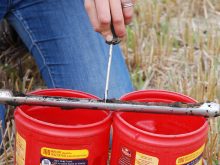A long, cold winter, a late spring and a possible increasing resistance to antibiotics may be behind the massive death loss in Alberta bees this spring, a provincial government survey has found.
Alberta bee colonies suffered a 30 percent mortality rate this spring, double the long-term average. An additional 15 percent of the surviving colonies were weak, according to the survey of 112 beekeepers with 400 or more colonies.
Paul Laflamme, a unit leader with pest management systems in Alberta Agriculture, said the survey was requested by beekeepers worried about the large death loss.
Read Also

AI expected to make itself felt in food systems
Artificial intelligence is already transforming the food we eat, how farmers produce it and how it reaches the consumer, experts say
“We wanted to know the extent of the winterkill and try to find out what caused the losses,” he said.
One beekeeper reported normal death losses in one yard but losses of 80 to 90 percent in another yard.
“It was very baffling for both beekeepers and ourselves,” Laflamme said.
The survey ruled out starvation and colony collapse disorder, which has caused millions of dollars worth of losses in American hives.
Instead, it pointed to a variety of factors that created the perfect conditions for increased death losses. The lowest winterkill loss was in southern Alberta and the highest losses were in the Peace River region, where winter was more severe.
Last year late summer rain prolonged the nectar flow of clover, allowing bees to produce an above average crop. The abundant production encouraged the retention of summer bees and a reduction of winter bees, which are late season bees especially adapted to survive winter and keep the hive warm during the winter.
This year’s late spring also prevented the bees from finding good nectar necessary for spring survival.
“It was definitely unusual winter conditions.”
Beekeepers have noticed a growing varroa mite resistance to miticides, making the bees more susceptible to winterkill. The survey found that the early onset of winter made it difficult for beekeepers to use alternative controls for the mite.
This spring beekeepers also reported a higher than normal incidence of nosema-like symptoms, a type of diarrhea in bees.
Cold weather kept the bees inside the hives, which resulted in hive contamination.
Other viruses and pathogens present in the hives added stress to over-wintering colonies.
While the survey showed common elements among beekeepers, Laflamme said there were no concrete answers as to what happened to the bees. Until some are found, Alberta’s provincial apiculturist has created a fact sheet of good management practices beekeepers should follow.
The increased winterkill was reported across the country.
In Canada, the overall over-winter mortality was 29 percent. In New Brunswick losses were 59 percent but that province represents only three percent of the country’s colonies. Ontario had 37 percent death loss in its over-wintering colonies.
















